Playwright A. S. Peterson on “A Christmas Carol”

I met A. S. “Pete” Peterson, playwright of the Rabbit Room Theatre’s adaptation of A Christmas Carol at World Vision in Cool Springs, where the organization is allowing the theatre to use their back warehouse as a rehearsal space. Pete gave me a sneak-peek at rehearsal, where about 15 people were running the scene where Scrooge visits his past childhood. The room was full: Victorian costumes hanging on racks, varied antique chairs and trunks and assorted furniture lining the walls of the room. The rehearsal focused on the motion of the scene. After a minute or two in the rehearsal, we stepped out to talk at a table in the lobby with the sound of rehearsal in the background.
Grace: I wanted to start off asking you about your background: how did you get into playwriting? I saw on the Rabbit Room website that you have adapted The Hiding Place and Frankenstein, and some other projects as well.
Pete: It was an accident. I was a novelist initially. And then Matt Logan, who is directing this show, somebody gave him one of my books and he read it, and was at the moment thinking about adapting the Battle of Franklin. He just had envisioned some sort of stage adaptation of the battle that happened in Franklin, Tennessee during the Civil War. He didn’t really know what that was going to be; was it just music, was it songs, was it a documentary? He wasn’t sure, but he read enough of my book to think I have a way up with words that would apply to the story well. So he asked me, “Hey, would you be willing to write this?” And I was like, “Well, sure, why not?” Didn’t know what I was getting into. Once I said yes, he told me, “By the way, we open in two months and we’re already selling tickets.” [Both laugh] I was like, “Oh, okay.” So it was a very quick development of that show, but it was just really creatively satisfying. Matt and I worked together really well.
We were really happy with how that show came out and I felt a creative, artistic awakening that happened in me, because there’s a big difference between writing novels and writing for the stage. Novel writing is very solitary. And then you’re also very much in control of the final product. Whereas playwriting, it’s very collaborative from the beginning to the end, and ultimately, I’m only providing sort of a scaffold onto which all these other artists actually graft their own crafts, like the set designer and the musicians and singers, actors, director, costumes. All this enhances the thing that I’ve created with the script. So that was a really satisfying process for me to have the benefit of all these other people who are great at what they do and make what I’m bringing even better than I could make it myself. So that was a great first experience. I think it was in 2016 and we’ve been doing about a show every other year since then. And we would do them all the time if we could find funding. [Pete laughs] But yeah, it’s just a big process. I will say what’s changed a lot over the years, since The Battle of Franklin, when the development cycle was very short and very stressful. Since then we’ve grown into a better understanding of how to develop a show. So with Frankenstein, we did a number of workshops going into that adaptation, and then with The Hiding Place, even more of that. A Christmas Carol, now, we’ve been working on this show for more than a year through workshops: movement workshops, staging workshops, and all these different things before we get into rehearsal, so that hopefully, by the time it makes it to stage, it’s a much more refined show that we put a lot of thought and work into. And that’s really creatively satisfying.
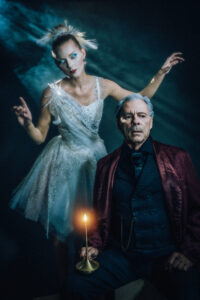
Grace: When you’re adapting a work of art, especially Dickens, there’s so much personality just in the narrative descriptions alone. In A Christmas Carol, a super quotable part is at the very beginning when he’s saying, “What does dead as a doornail even mean? Shouldn’t it be a coffin nail?” Depending on whether you’re doing narration, has it been challenging to get that flavor into the dialogue?
Pete: Great question. It is a challenge, but it’s fun. Dickens is one of my favorite writers. I’ve always loved Dickens. So the opportunity to kind of co-write with Dickens is a lot of fun. Air quotes are on co-write. But yeah, I enjoy his language so much, and a lot of the things that I’ve written are period pieces, so I like writing in that style. It’s a great opportunity for me to figure out, how do I match my style with Dickens? And so the goal is that by the time somebody comes to the show, they don’t know which lines are Dickens’ and which are mine. That’s a fun challenge. But my goal is not to change A Christmas Carol so that it’s some other story. My goal is to align myself and my voice with Dickens’ voice so that there is a unique expression of his story that comes out that is still clearly a full embodiment of what he created. If that makes sense. And that’s a balancing act. So if you come to see the show, it does not begin with the same words that the novel begins with, that everybody’s so familiar with. I take the opportunity to build up to those lines and then surprise people with them when they show up.
But then at the same time, because I’m such a fan of Dickens, I did a lot of research into his creation of this story, and it was interesting to me to learn that he had been on a tour of the United Kingdom specifically to investigate the conditions of child labor in the country at the time. Lots of children, young children working in terrible conditions and factories and mines and all this kind of stuff. And because he had been abused as a child by being sent off at 11 years old to work in a factory, he had a special concern for children and wanted to see if that was still the case. Well, he came back from that tour recognizing that not only was it still the case, but the society at large was really apathetic to it and was ignoring it. And so he sat down to write a pamphlet to expose the evils of child labor and the apathy of 19th century British society. And as he started writing his pamphlet, because he’s a storyteller, he accidentally wrote a story instead, and that story is A Christmas Carol, which is centered so much on the abuse of children. Scrooge when he was a child was not treated well, and that comes out in the story. Tiny Tim is not treated well, and he’s dying throughout the story. During the Ghost of Christmas Present segments, these two children come out of the robes called Ignorance and Want, and it’s all a warning to society like, “Hey, we have to pay attention to what’s happening right here.” So that was interesting to me, which led into our partnership with World Vision, which is where we’re at now. World Vision has a mission to support children in need, to help the world. So they’re really a great partnership there.
The other thing I learned in my research was how autobiographical A Christmas Carol is. It’s not autobiographical in that Scrooge is Dickens, but a lot of the details of this story and of the circumstances of the story are true to Dickens’ own life. So Scrooge loses a sister through the course of the story, which affects him emotionally. The same thing happened to Dickens. One of the children in Scrooge’s family died in youth, which is very like Tiny Tim. There are a lot of these parallel occurrences in the story. And so having also a love of David Copperfield, which is an autobiographical story that Dickens wrote, I took the opportunity to pull some of David Copperfield stuff into this one. So there are certain characters in A Christmas Carol that Dickens never actually names, and I’ve chosen to give them the names of people from David Copperfield and kind of mix the two stories a little bit. So anybody that’s watching the show that’s a fan of Dickens in general, I think they’ll pick up on little Easter eggs here and there that are borrowed from this Dickens universe. But if you haven’t, you’re not going to notice that. It’s just part of the story. So that was a lot of fun as a writer to work on.
The same as with The Hiding Place, the goal of adaptation, for me at least, is that it will be a fusion of my voice with the original author’s, but if I’ve done it well when people walk out of the show they will think, “Oh, that was just perfect. It was a perfect translation from book to stage. You didn’t change a thing.” Because differences evaporate if an adaptation is done well. I think a great example of that is Peter Jackson’s Lord of the Rings movies. They are wildly different from the books, but they do such a good job of capturing the heart and the tone of the books that people often don’t even realize how much they’ve changed. And I think that’s a sign of a good adaptation.
Grace: A Christmas Carol is one of the most adapted plays in the English language. I know it’s because people love Dickens, and also sometimes to avoid licensing fees. What was your goal in this project, besides of course wanting to do the perfect adaptation? Did you think “Every time people adapt it, they always mess up this part, and I want to get this part right?”
Pete: Well, I don’t know that it’s that, so much as there are parts of the book that are mostly left out of adaptations, small little things that happen throughout. And I thought, it’s such a short story, I think we can actually bring those things back in an interesting way. So there are several moments that happen in the book that you usually don’t see in adaptations, that we are reclaiming here. Which is fun for me. I don’t want to talk about them specifically; I want people to see the show. But if you are a fan of the book, if you’re one of these people who reads it every year, I think it’ll be fun to finally see somebody put this on stage, because it doesn’t usually show up.
But then on the other hand, you asked why, it’s one of the most adapted stories in the English language. It begs the question, why do it again when there are so many other adaptations out there? My answer is that storytelling is part of what makes us human. Telling and retelling stories is such an enormous part of human culture, from Homer to Milton to the Bible, to King Arthur. All of these other stories that exist and we retell and retell and retell, generation after generation after generation. I think the reason that we do that is because we we sense that there is a real, powerful, profound truth at the heart of these tales and that we feel called to retell them for our own generation, and to draw out the things that are reflective of our own culture and our own time and our own society, and how they speak to us today in a way that’s maybe different than they spoke to the last generation. So I think it’s really important to continue adapting and retelling stories when we happen across these fundamental, profound tales that resonate so profoundly with the whole society. And so that’s what I’m trying to do. I’m trying to figure out how to tell it in my own way that talks to the current time.
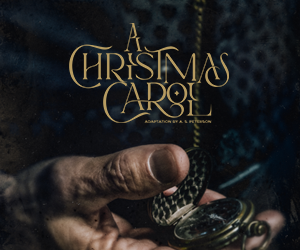 Grace: Going back a little bit, but you mentioned Ignorance and Want and child labor. You mentioned being a partner with World Vision. At least within the US and Tennessee, I don’t hear much about local issues with this, like “Oh no, Target’s doing child labor in Cool Springs!” Are you focusing on it on a more global scale? Or are you shifting that message slightly?
Grace: Going back a little bit, but you mentioned Ignorance and Want and child labor. You mentioned being a partner with World Vision. At least within the US and Tennessee, I don’t hear much about local issues with this, like “Oh no, Target’s doing child labor in Cool Springs!” Are you focusing on it on a more global scale? Or are you shifting that message slightly?
Pete: Well, in the context of the story, it doesn’t shift a lot. It’s still about Victorian England. That’s the terms in which they’re dealing with it. But I think that the way they’re thinking about problems and ills and society is applicable to the way we think about them today. So even though it might not be happening in the same way down the street here in Nashville, it is happening in the world. I’ve heard some organizations say that there are more slaves in the world now than there have ever been. Which is a real problem. So it’s not that the problems have gone away, they’ve just moved around. So using a story like Dickens’ A Christmas Carol to think through how we participate in generosity, how we participate in equality and income disparities and all those kinds of things are just as applicable today as they were for Scrooge. So when Scrooge is saying things like, “if the poor would rather die than they had better do it and decrease the surplus population,” I hear those kinds of things said today. So it’s just as relevant now as it ever was.
Grace: Do you have a favorite adaptation of A Christmas Carol?
Pete: I don’t know. I mean, I feel like it’s a cliché to say my favorite is the Muppets, but it kind of is, it’s just so charming. I’ve often joked that I’ve seen so many adaptations of A Christmas Carol, and I feel like all of them disappoint me in one way or another. They’re all good in many ways, and then there are a few moments where I think, oh, that didn’t feel right, that’s not the way that I wanted it to be. As I’m adapting my own, I’ve often joked that I’m going to disappoint people in a new way. [Laughs] Which is obviously not my goal, but it is inevitable. People will come and they will see some things about this show and think, “That is the best version of that scene I’ve ever seen.” And then this other scene they’ll think, “Ohh, but I liked that one better in the Muppets.” And I think that’s totally valid, totally fair. But that’s part of the joy of adapting a story and participating in this tradition of retelling; we’re all doing it in subtly different ways and we’re all going to succeed in different ways.
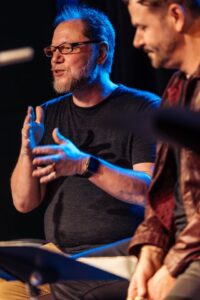
Grace: Are you doing a full cast? It seems like you have a pretty full room of actors and actresses in there.
Pete: It’s a very sumptuous production, I would say. I think we have 17, 18 people in the cast. So we’re envisioning it in an unique way, in that it’s an ensemble piece, meaning that all of these people are participating in the show throughout. The way that that works is we’re taking the angle of a spirit world being omnipresent. In the book there are the three spirits who haunt Scrooge. And in our story, those three spirits are there, but they’re also surrounded by a spirit world that’s observing and inhabiting and watching what’s happening to Scrooge all the way throughout the story. So that all these actors are participating at one time or another in manifesting the world that we’re putting on stage, if that makes sense.
Grace: I was looked up the cast and the director, and it’s great, featuring Nashville theater familiars like Jennifer Whitcomb-Oliva. The director has done a bunch of professional stuff too. As a small theater, how did you get such a great group of people together?
Pete: Well, Matt and I, the director and I had been working together, like I said, for about 10 years. And we’ve just got a real passion for doing theater at the highest possible level. The talent that’s on display here in Nashville in the theater community is every bit as good as it is in LA, Chicago, New York, London. The people that we’ve got here in town are extraordinary. And so we’re committed to putting together theater projects that are going to show off their talents in the best possible way. I feel like all of the shows that we’ve done are examples of that and A Christmas Carol is our next iteration of just trying to do the highest quality theater in the best way that we can.
We’re bringing movement into it in some interesting ways that we first experimented with in The Hiding Place, through choreographed movement. I’m excited that we’re blowing on those embers here in this show to add a little bit more of that choreography into it to help to tell the story. As we’ve proceeded through the years and all of our shows, we’ve just gathered a really great cast of actors that we keep going back to again and again, like Jennifer Whitcomb-Oliva, Gerris Wimmer, Chip Arnold, all of these folks. They’re just so talented. Every time we do a production, it feels a little like a family reunion, because we’re all so comfortable with each other, we know each other’s personalities and creative strengths. So it makes for a really fruitful atmosphere in which to try to create something new when you have this feeling of safety and creativity together.
Grace: When you were writing this, did you have an idea for the music or special effects? I know the costumes are Victorian, but there are always challenges: how do you do the Ghost of Christmas Past with the candle and the flame, and how do you do the Ghost of Christmas Future? Did you have anything specific in mind? I don’t know if you want to give spoilers.
Pete: I don’t want to reveal a whole lot. I mean, we’re not going the direction of things flying around on wires, I’m much more a fan of what theater does really well: abstracting things. So finding artful ways to create theater magic that will invoke the audience’s imagination as a participant. If you want somebody to flip a coin, you can actually put a coin in their hand and then have the mechanics of it going up and then having to catch it. But you don’t have to do that. You can just have the motion [he mimes tossing a coin], and the audience will just go with it. And so that’s the way I write. I try to write in such a way that Matt and the choreographers and all these people will be able to lean into the kind of abstract theater magic that you can accomplish without necessarily having a bunch of bells and technical whistles. But having said that, we will have projections, we will have various lighting cues and things that will develop that theater magic in a more technical way. But it’s a more movement-based theater magic that’s embodied by actors as opposed to involving a lot of smoke and mirrors and lights and cables and that kind of stuff, if that makes sense. I think ultimately it can make for, if not a better, a just as good experience for the audience as the big technical wizardry that you see on Broadway sometimes, because it really forces the audience to lean in and participate in a different way via the imagination.
Grace: So, I have a couple of questions that are slightly off from just this play specifically, but a little bit more about the Rabbit Room Theatre itself. Y’all are a Christian group wanting to do art more like Dorothy Sayers, GK Chesterton, those sorts of creators.
Pete: Yes, so the Rabbit Room is sort of born out of the tradition of the Inklings. The Inklings being Tolkein, C.S. Lewis, and their vein of literature, which includes Dorothy Sayers, G.K. Chesterton, George McDonald, all these kinds of folks. The Inklings would meet at the local pub every Thursday and talk about the books they were writing and tell stories and just have fellowship with one another, encourage one another and their creative processes. And so the Rabbit Room was born out of a desire to create that kind of atmosphere here in Nashville, just trying to draw artists together to be accountable to one another and see what happened. And so that’s been going on for almost 20 years now. It’s been really successful. A lot of those people that were that original core have gone to have multiple books in publication, multiple albums, lots of creative output. And since then it’s spread globally. We have conferences here in the US once a year, we have conferences in the UK, multiple events throughout the year, several bestselling titles via Rabbit Room press, which is our publishing arm. And then most recently we decided to launch Rabbit Room Theatre as just another discipline that we wanted to really clearly represent as being meaningful for the world and for the Church. And so The Hiding Place was our original production. That looks like me trying to pull together people here in town and abroad, people who are talented at theater and really passionate about telling profound truth through theater.
Now, because the Rabbit Room is a Christian organization, because I’m a Christian, anything I can write or create is going to be foundationally Christian, and then it’s expressed through the stories we tell in subtle ways. We’re not out to preach the audience. We’re out to tell great stories and do great theater. And I think that’s good for the world, whether it’s explicitly Christian or not. So A Christmas Carol is a very popularly accepted tale. It’s also got some really fundamental Christian truth at the heart of it. And I think that really clearly fits our mission. But you can say the same thing about Les Mis and Fiddler on the Roof and lots of great stories that are out there. So, that’s where we’re coming from. We are a Christian organization, but we want the storytelling that we do to appeal to and involve people from all sorts of different perspectives.
Grace: I’m part of the church and I grew up in the church, but growing up here in Nashville, in the Bible belt –and maybe we’re the buckle of the Bible belt when it comes to commercial arts and Christianity meeting– when I think of Christian arts I think of Lifeway and Pure Flix, maybe not aesthetically um…
Pete: You think of propaganda. [Both laugh]
Grace: Yeah, so have you guys had any challenges if you’re trying to do Christian art?
Pete: We think a lot about the kind of stories we want to tell. We are very excellence and art forward. I believe if we tell a story well it will tell the truth well. Somebody said at one point, if you want people to know the truth, tell them the truth, if you want people to love the truth, tell them a story. And that’s kind of where I’m coming from. But on the other hand, the goal of me telling a story is not to communicate some backchannel message. I’m not trying to convert people to Christianity through storytelling. I’m trying to tell stories really well, and then because I’m a Christian, I believe that the Holy Spirit is involved in that work and will do his work through the great stories that we tell. And I think there’s a subtle difference there. We also want this to be appealing to anybody. I don’t want to chase off people.
A great example is when we did The Hiding Place. It’s the story of Corrie Ten Boom. She and her family hid Jews in their home during World War II in Holland, and they were eventually caught, sent to a concentration camp. and most of her family died. Corrie survived, and then she spent the rest of her life touring the world and telling people about what she’d experienced and telling people about Jesus. She’s beloved by people, and it’s a very Christian story. But when I was asked to adapt it, one of the things I said was, “I would love to do this, but I feel very strongly: we need to find a way to tell this story in a way that it can be hearable by people outside of the church. I’m not interested in a Sunday school lesson.” So as we developed that show, we showed it to the Jewish community, we showed it to a secular community, and asked them, “Hey, does this feel true and is it setting off your alarm bells that it’s Christian in some inappropriate way?” And repeatedly, we got feedback to the tune of “This isn’t Christian, this is about Jesus. I have problems with Christianity, but I love what Jesus has to say, and that’s what I’m getting through this story.” And that felt like we were on the right track. It wasn’t putting people off, it was drawing people in, because it was chiefly about humanity and their relationship with their individual faith. And I think that’s attractive to people in a way that it’s not when you’re telling a story in a way that’s pointing at the audience and saying, “You need to believe this.” It’s different when you’re pointing at yourself and you say “This is what I believe.” Does that make sense? So, yeah, it’s a delicate balancing act.
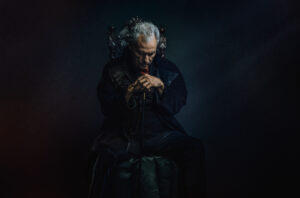
Grace: I’ve heard of A Christmas Carol spoken of as an introduction to the secular Christmas or the Christmas about family coming together, because although there are many Christian virtues in it, there’s no focus on it being the Christian holiday celebrating the birth of Jesus.
Pete: In the book, I think it’s very explicit. Dickens comes right out and says there’s no better time to be a child than at Christmas when its founder was a child himself. And then there’s this great scene, which I’ve included in the play, between Scrooge and Christmas Present, where the ghost is showing Scrooge all of the joy and all this feasting and stuff and Scrooge says, “But why if all this is true, do you, Christmas, deny the poor their food every seventh day? Because on Sunday you force all the pubs and the restaurants to be closed.” And Christmas turns around to Scrooge and says, “Look, don’t blame me for that. That’s not what I’ve done. That’s what men have done, and what I am advocating for, me, Christmas (which is the Church universal) is something much greater than that.” And so there’s this plea to not misunderstand the church and the wrong that it does sometimes for the thing that it’s actually trying to reflect, which is Christ. And so Dickens had strong feelings about those things and it is there in the book in ways that are subtle enough that it often gets edited out when it finds its way into a movie or to a stage play. But I like to think that we’ve found ways to include those things without snapping anybody out of the story.
Grace: Starting in December, there are two other theater adaptations of A Christmas Carol besides your production. When people are trying to decide which show to see, what reason would you give to see yours specifically?
Pete: I don’t want to just say, because ours is the best. I mean, I do think this is an original adaptation. Nobody has seen this one before, it’s a world premiere, and it features some of the best talent there is in this area, if not in the country. We do have people we brought in from outside of town just because they’re talented. I think it’s going to be a great story, it’s a great adaptation. If you’re at all familiar with my past work or the Rabbit Room’s work, I think you’ll have a good indication of the kind of richness of language and storytelling that we aim at. I know we have folks in the Rabbit Room community coming from all over the country to see it, which is encouraging. But I think ultimately, we’re trying to find a subtly new perspective on the story that will be really interesting to people. And I don’t want to spoil things and I also don’t want to imply that this is some wild new adaptation, like it’s science fiction or something. It is not. It is very reliably the Christmas Carol that we’re used to, but I think the way in which we move the lens to highlight a different aspect of the story is going to be surprising and really pleasing to people. I think it will be a spin on the tale that people have not quite seen before. And I think that’s going to be a really good thing.
Grace: Thanks for a great conversation!
Pete: Thank you.
The Rabbit Room Theatre’s production of A Christmas Carol will be December 7-22 at the FSSD Performing Arts Center in Franklin. For tickets and more information, see Rabbit Room Theatre.



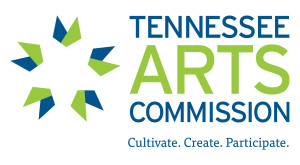
[…] aspect of the play that playwright A. S. Peterson mentioned several times in the MCR interview (Playwright A. S. Peterson on “A Christmas Carol” – The Music City Review) is the use of choreography and movement in the show. Elyn Collier’s choreography is excellent. […]